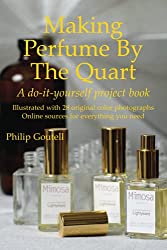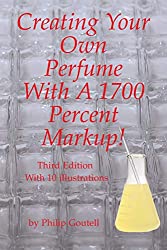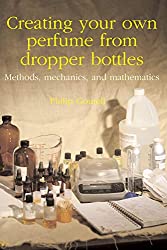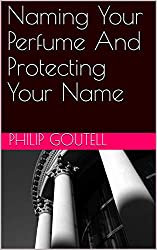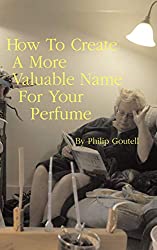Perfume Production — converting grams to milliliters
Note: This article is a follow-up on a blog post found here — And I've posted a video showing how we set up the electronic balance here. A video showing the procedures explained below has been posted at YouTube here.
Having developed a perfume formula with dropper bottlers and then converting the drops to grams and percents, I now want to calculate the weight in grams of a milliliter of my fragrance. Why? Because when I produce my finished perfume, I'll want to produce a particular quantity of it and that quantity will be specified in a volume, liters (or milliliters) or gallons (or fluid ounces), not by weight.
NOTE: Production of a mass market fragrance might well be by weight, perhaps by tons. For small scale production such as mine, measurement by volume is more practical. It involves less weighing and eliminates the need for extremely accurate (and expensive!) measuring tools.
For this current project (which is basically an educational exercise as at present I have no plans to market this formula) I've decided to fill 30 29 ml (1 fluid ounce) bottles. This means I'll need 870 ml of the finished fragrance (30 x 29 = 870). To be on the safe side and allow for a few spills, I'll bump up that quantity to 900 ml.
So now the project lays out like this: For production I'll need —
| 135 ml of fragrance oil | |
| 765 ml of 90% alcohol | |
| To produce: | 900 ml of finished perfume |
Since the alcohol I have on hand is 100% (200 proof) ethanol and I want a 90% (180 proof) alcohol, I'll blend alcohol and water as follows —
| 76.5 ml water | |
| 688.5 ml 100% (200 proof) alcohol | |
| To give me: | 765.0 ml of 90% (180 proof) alcohol |
Now comes the issue which has led to this article. Measuring the alcohol and water is easy. I'll use a 1,000 ml household measuring cup. I'll measure out the 688.5 ml of alcohol first and pour it into the bottle that will hold my finished perfume. Then, using the same measuring cut (without washing it), I'll measure out the 76.5 ml of water.
NOTE: I measure the alcohol first because then, when the same measuring cup is used for the water, it will "wash" away any alcohol that was left in the cup and pour it, with the rest of the water, into the bottle. (You can read why I used de-ionized water in this article.)
The glitch comes with the fragrance oil. I need to produce 135 ml of it but my formula is calculated in percents of weights of my ingredients. When I produce the formula itself, prior to mixing it with alcohol and water, I'll produce it by weight. But what weight? How many grams of my formula must I produce to yield a volume of 135 ml?
I must now calculate the weight of 135 ml of my oil.
The math is simple. I'll just multiply the weight of one milliliter of my oil by 135. But first I must measure the weight of one milliliter. Out comes the electronic balance. (See my video for setting up an electronic balance.)
To calculate the weight in grams of one milliliter of my fragrance oil I'll use a graduated measuring column, in this case a small, ten milliliter column.
I'll start by weighing the column. This gives me the tare weight, the weight of the column itself, and I'll record this weight in my notes. In this case the column alone weighs 30.703 grams.
Next I'll pour some of the oil to be weighed into the column. Since I'm using the oil I produced in my "drops to grams to percents" conversion, I only have enough to fill the column to the 3 ml mark. My "grams per milliliter" results would be more accurate if I was using more oil but, at the moment, this is all I have.
Now I weigh the column again, with its 3 ml of my fragrance oil, and I record this weight in my notebook. The column with 3 ml of fragrance weighs 33.643 grams.
By subtracting the weight of the empty column from the weight of the column filled with 3 ml of my oil, I get the weight of 3 ml of the oil —
| 33.643 grams, column with 3 ml of oil |
| 30.703 grams, column empty |
| 2.940 grams, weight of 3 ml of oil |
Now I divide 2.940 by 3 to get the weight of one grams of oil. (2.940/3 = 0.98). So one milliliter of my oil weights 0.98 grams.
Since I need 180 ml of oil to produce my 900 ml of finished fragrance, I multiply 0.98 by 180 and find that I'll need 176.4 grams of oil to supply the required 180 milliliters. (0.98 ml x 180 = 176.4 ml)
Now, using the percentages in my formula, which will show me how many grams of each material I'll need, I'm ready to produce 180 ml of oil.
5000g / 0.01g Portable electronic balance laboratory digital scale features white backlight function for convenient reading in the darkness. Lightweight and small-sized design makes it portable in use. It features high-precision and good performance, which ensure the accuracy of measurement. High quality keeps it durable and stable during use.
Specifications:
1. Max. Weight Range: 5000g
2. Accuracy Resolution: 0.01g
3. Units: g, kg, ct, oz, ozt, lb, dwt, %, tol, mm
4. Display: LCD
5. Background Light Color: White
6. Material: ABS
7. Pan size: 180* 140mm
8. Power Adapter: AC 90V-240V(Input); 8.5V,500mA(Output)
- COMPLETELY PURE - Although tap water has been filtered to make it safe for human consumption, it still contains trace minerals. Our sterile water has been thoroughly purified and mineral-free.
- ENSURE TOTAL ACCURACY - When conducting lab tests, using tap water can introduce impurities that affect the chemical composition. Deionized water will get you the most accurate results.
- A STABLE INGREDIENT - Pharmaceuticals, cosmetics, and hygiene products use distilled or deionized water. Its purity makes it a reliable choice for maintaining product safety and integrity.
- SUITABLE FOR MACHINERY - Deionized water is also widely used in industrial applications. Cleaning, cooling, and lubricating with it as opposed to regular water helps prevent corrosion damage.
- GREAT FOR CARS - Whether you're topping off your car's coolant system or washing off dirt and grime, this sterile 1 gallon bottled water is a smart choice. Prevent water spots on your vehicle!
Stainless Steel Funnels for Kitchen: These stainless steel funnels are made of food grade stainless steel, non-toxic and sturdy. Premium material makes these small funnels have a long usage time and resists breaking, bending, scratching, rusting. Each Stainless Steel funnel has a perfectly narrow stem, ideal for filling small bottles and containers while keeping the kitchen counter free from spills. Each funnel's stem is equipped with an indent (air release channel), which allows funnels to vent and allows contents to flow better. Perfect for adding salt, pepper, herbs or spices into shakers or jars; transferring oils and vinegars into cruets or small decorative bottles for gifts; adding powdered drink mixes into water bottles and much more.
3.3 Borosilicate glass, Griffin low form, 3 sizes - 50ml, 100ml, 250ml, Extra large marking spot, ASTM Specification E960, Type I requirements.
Homemade perfumes generally lack commercial value, regardless of how wonderful they may be, because their creators fail to record how their perfumes were made. To profit from a perfume, to sell it, to sell the rights to it, or have somebody sell it for you, you must be able to make more of it. To make more you need the formula, the record of how the perfume was made: what materials were used and how much of each material was used. While the formula is nothing more than a recipe, a simple piece of paper, it is the key to unlocking your perfume's commercial potential. With the formula in your hand you have the ability to make a few dozen bottles more or, like the celebrities, tens of thousands of bottles. How to create an international production formula for your homemade perfume is a guide to getting you started on the right foot, correctly documenting everything you do as you are doing it, and then using these notes with some basic mathematics to write a simple, accurate, universal formula for your perfume. Writing formulas for your perfumes can change the way you think about them. With your formulas in hand your creations are no longer "here today, gone tomorrow." Now, thanks to your library of formulas, your perfumes become immortal!
While much is written about perfume – the beautiful fragrances... the beautiful bottles – little is available on the "mechanics" of perfume production – the steps that take place on the "factory floor" where a beautiful vision is turned into a finished product, a "ready to sell" perfume. Now you can experience all of these steps, hands on, by making just one quart of your own perfume. If you follow each chapter and do what you are instructed to do, you will end up with from 8 to 64 bottles of your own perfume, depending on the capacity of the bottles you select. Along this "insiders journey," each step is profusely illustrated with professional color photographs and you'll learn — • Exactly what alcohol you'll need and where to get it • Why you'll want (just a little!) water in your perfume • What type bottles you'll need and why you cannot use others • Why you will use a spray and not a cap • How to fill and seal your bottles • How to label your bottles with the correct information so they will be legal for sale • How to select a name for your perfume that will allow you to acquire powerful trademark rights free. If you are a developer of scents you are encouraged to use one of your own for this project. If you are not a scent creator yourself you'll learn how to get a fragrance oil that is exactly right for this project. Online sources are given for all required supplies and materials. Nothing can hold you back from starting your project immediately!
Perfume is famous for the markup it can achieve, even for a middle market fragrance. While "everybody knows" that perfume costs next to nothing to make (not completely true) the making of it is often considered an esoteric secret. "Creating Your Own Perfume With A 1700 Percent Markup!" details how a 3-person company with no experience created their own fragrance in response to a marketing opportunity that was too good to pass up. The book explains exactly what was done to create a fragrance for that opportunity but it is far more than a history of the author's project. "Creating Your Own Perfume With A 1700 Percent Markup!" lays out every step in the process of creating your own perfume, either as a do-it-yourself project – and without the benefit of automated equipment some compromises and workarounds are required – or full bore professional production under your supervision. Either way you will be producing a quality fragrance at a remarkably low cost. Do you have a marketing opportunity that would be wildly profitable if only you could obtain your fragrance at a ridiculously low cost? "Creating Your Own Perfume With A 1700 Percent Markup!" is the guide you need to do it.
Now when you make your own perfume you can make it fully "commercial" meaning you will be creating a product ready for regular, continuous sales to friends, relatives, and the public! If the fragrance you've made has already won praise, why not share it with others? Some might pay you for it and want it for their web stores or retail boutiques! Creating your own perfume from dropper bottles: Methods, mechanics, and mathematics guides you through steps that can turn your hobby project into a perfume business. Discover how close you are now and how little more you must do to take what you made with essential oils and dropper bottles into a business of your own! For an introduction to this book, watch this video.
You can build a perfume business of your own using this business plan as a guide. By following its detailed strategy you learn to identify motivated groups of potential perfume buyers. Members of these groups are near the tipping point of desire for a new perfume. You don't know these people and they don't know you but you know a marketer they trust, one who does not currently sell perfume and might never think of selling perfume were it not for your approach. Here is where you step in with a professional plan, promotion, and perfume to take advantage of this ripe opportunity for mutual profit. Before your first promotion has peaked, you will already be developing a relationship with your next marketing partner. Following this plan, you will gain more and more profit with each new marketing partnership.
A really great name, a special name that is just right for a particular perfume or perfume marketer (or entrepreneur with money to invest!) can be worth a ton of money. But few individuals with great ideas ever manage to cash in on those brilliant ideas. Instead they wait while others "discover" their idea, acquire legal rights to it and make all the money while they are left out in the cold without a penny having been earned for what was once THEIR idea.
If you are struggling to name your perfume and are looking for a name that will have real value, "Naming Your Perfume And Protecting Your Name" will help you weed out low value names and point you to names that have better marketing value plus the potential to become valuable assets in themselves.
If you have a great name you want to protect but no fragrance, "Naming Your Perfume And Protecting Your Name" will guide you through the simple steps you must take to acquire a legal right to that name before someone else grabs it! Best of all, "Naming Your Perfume And Protecting Your Name" shows you how to gain strong legal protection for your name without a lawyer and without spending more than pocket change.
Never had an idea for a product name? Never thought much about perfume? "Naming Your Perfume And Protecting Your Name" may stimulate your interest in a whole new game that, when played well, can make you lots of money without your having to leave the comfort of your home office.
When you name a perfume you create a valuable asset – the name itself. To sell your perfume you want the most effective name possible. But a good name can have value beyond the edge it gives your sales. In naming your fragrance you are creating a trademark and a trademark can have value independent of the product. The value of that trademark can vary. Much depends on how well, in naming your perfume, you follow the trademark "rules." How To Create A More Valuable Name For Your Perfume first helps you develop a name that will be effective in selling your perfume. It then prods you to make use of certain techniques that can turn a good name into a great trademark, strong and valuable. If you have questions about how to protect a name, How To Create A More Valuable Name For Your Perfume will answer many such as:
- Can you protect your name yourself or do you need a lawyer?
- Can you register a trademark without a lawyer?
- What does it cost to register a trademark?
- How do I enforce the rights I have established?
How To Create A More Valuable Name For Your Perfume covers both state, federal, and international protection.
For article updates, etc., add your name to Phil's mailing list.


Philip Goutell
Lightyears, Inc.






